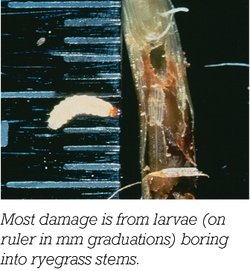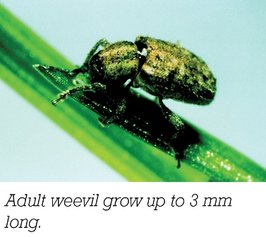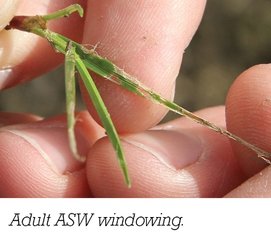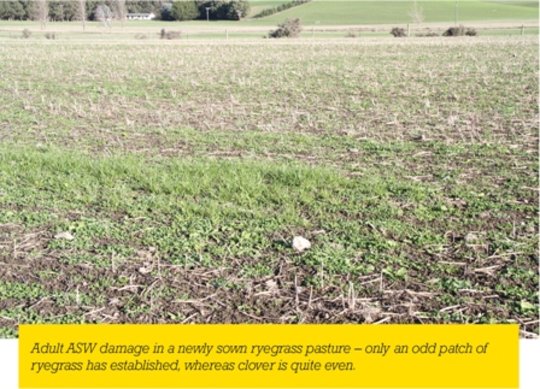Argentine stem weevil (ASW)
Argentine stem weevil (ASW) is a pest of short-term ryegrass and perennial ryegrass Without endophyte throughout NZ. Adult ASW can damage establishing ryegrass, particularly cultivars with AR37 or Without endophyte. Seed treatment is important to protect new pastures.
Identification
ASW larvae destroy ryegrass tillers by boring into the base of their stems. Populations can reach 500-1000 larvae/m², causing significant pasture damage.
To find larvae, look for dead or dying central leaves in tillers, that when lightly pulled come straight out of the plant - due to being eaten at the base of the stem. The base of these stems show a small hole (if larvae are still inside) or significant damage inside as in the photo.

Larval damage mainly occurs from mid October to mid April. It is usually seen when pastures are growing slowly, and is often confused with drought stress. Younger pastures seem to be more susceptible than older ones.
In most areas, ASW have two generations a year, one in spring and another in summer. Generally the summer generation is the most damaging, between January and March.

Adult weevil feeding is characterised by small rectangular ‘windows’ 2-3 mm long on the leaf blade (shown in photo). Adults do not affect the persistence of established pasture, but can kill ryegrass at establishment.

Prevention and management
Establishment
New ryegrass can fail from adult ASW attack in late spring-autumn. This is most common in grass to grass or cereal to grass sowings with minimal tillage, or when undersowing into existing pasture, as ASW numbers can build up on the previous grass or cereal. Good cultivation practices minimise ASW numbers, however if turf or plant sods remain intact ASW may survive on these.
Adult ASW and larvae can kill ryegrass seedlings as they first emerge, predominately in the first few weeks after sowing. Beware dry conditions – these slow establishment, leaving plants in a vulnerable stage for longer..

Seed treatment
If sowing ryegrass where adult and larval ASW are potential problems, use a suitable seed treatment (e.g. AGRICOTE Grass) to help protect new seedlings. Additionally, in grass to grass or cereal to grass spray-drill situations where ASW numbers can be high, add an appropriate insecticide to the final glyphosate spray before sowing to reduce the ASW population.
Endophytes AR37, NEA12, RGT18 and ryegrass Without endophyte give seedlings no protection against adult ASW. Other endophytes (NEA, NEA2, NEA4 and AR1) give some protection in newly sown pastures, but not as much as seed treatment.
Endophyte
Endophyte is an important tool for ongoing ASW control in a pasture. Once established, diploid perennial ryegrass containing NEA2, NEA4, NEA12, AR1, AR37 or RGT18 endophytes are likely to provide good ASW control in most situations.
Tetraploids versus diploids
Tetraploid ryegrass cultivars are more susceptible to ASW damage, as they are preferred by ASW, and have a lower tiller density, so they cannot withstand the same level of damage as diploids. In areas of high ASW damage (e.g. coastal Taranaki) tetraploids can be less persistent than diploid cultivars.
Biological control
A parasitoid wasp (Microtonus hyperdae) is now widespread, and helps alleviate damage caused by ASW, although recent evidence suggests its effectiveness has reduced since introduction.

